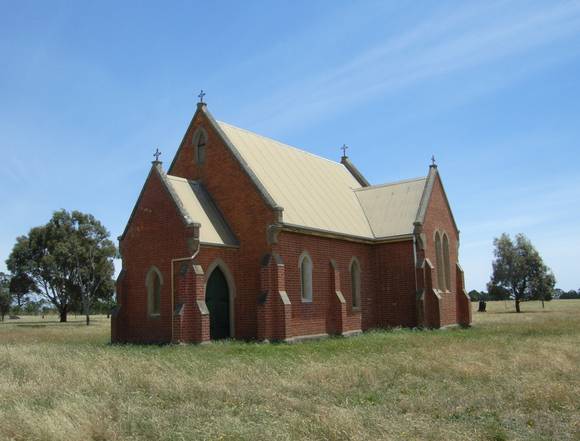| Back to search results » | Back to search page » |
|
ST PETERS ANGLICAN CHURCH
Location2460 CONDAH-COLERAINE ROAD TAHARA, GLENELG SHIRE
File NumberHER/1999/000026LevelRegistered |
|
Statement of Significance
What is significant?
St Peter's Anglican Church at Tahara was
dedicated in September 1881 by the first Bishop of Ballarat, the Right
Reverend Dr Samuel Thornton. Tahara township reserve was gazetted in
1869, and until the construction of the church the local population
held occasional church services at the nearby Murndal or Tahara
homesteads. The government ceased reserving land for religious
purposes in 1875, so to enable a church to be built at Tahara the
pastoralist Samuel Winter Cooke donated five acres of land and £1,000.
Winter Cooke, who had inherited the Murndal estate from his uncle in
1878, was a promoter of Christian knowledge and in his capacity as a
lay reader conducted religious services whenever the minister was
absent.
The architect of St Peter's was Frederick Wyatt, and the
contractors were Gordon, Carter and Cornish of Hamilton. The church is
set on a plinth of bluestone and built of tuckpointed red bricks,
which were burnt close to the site. The simple truss roof was
originally tiled with Welsh slate, but was replaced with a zincalume
covering in 1978. The layout of the church is a cruciform plan, and
the style is early English Gothic. The original windows were all quite
plain, with leaded glass in a lattice pattern. The vestry was added in
1933. The church is located in a dramatically isolated position,
looking over the Wannon River valley.
The five stained glass windows in the sanctuary were made by Percy
Bacon Bros. of London and were installed in 1903. These are the three
windows behind the altar, with St Peter and St Paul flanking Christ,
represented as the Good Shepherd. In the nave are St Cecilia and King
David. The St George window, also in the nave, was installed in 1921
and was the work of the celebrated Melbourne practitioner William
Montgomery. The Simeon window was dedicated in 1936 in memory of
Samuel Winter Cooke. Another member of the Winter Cooke family was
commemorated by a window in the nave designed by John Orval in 1979.
After construction of the church was completed in 1881 interior
furnishings, including the pews, were donated by Samuel Winter Cooke's
brother, Trevor. The pews are believed to have been made by James
Aylmer, son of Patrick Aylmer, the highly skilled carpenter at
Murndal. Several objects make a direct association between the church
and the Winter Cooke family. The altar was a gift from Samuel Winter
Cooke in 1903 and is carved from blackwood grown at Murndal. The
pulpit is of hand-carved English oak, and was sent out from England in
1929 as a gift to the church from the second wife of Samuel Winter
Cooke. The stone font was donated by Samuel Winter Cooke in memory of
a nephew who drowned in one of the Murndal dams.
How is it significant?
St Peter's Anglican Church at Tahara is
of historic and aesthetic significance to the State of Victoria.
Why is it significant?
St Peter's Anglican Church at Tahara is
historically significant for its close association with the pastoral
run of the Winter Cooke family at Murndal, located a few kilometres to
the east. The donation of land and money demonstrated the strong
paternalistic ties of a landowner to the local community, many of whom
were employed on the estate. It demonstrates the traditional
responsibilities for the welfare of their workers that the family felt
as members of the British landed class. The relationship between
Murndal and St Peter's is representative of similarly strong ties that
existed elsewhere in the state, and amongst other denominations.
St Peter's Anglican Church at Tahara is aesthetically significant
for the superb collection of stained glass windows by a variety of
manufacturers, both local and overseas. The simple and modest red
brick church located in a dramatic position overlooking the Wannon
River valley provides a bold setting to the collection of intricate
and finely executed stained glass. Changing fashions in imported and
locally produced stained glass are represented in the variety of
periods and styles present in the church.
Group
Religion
Category
Church





